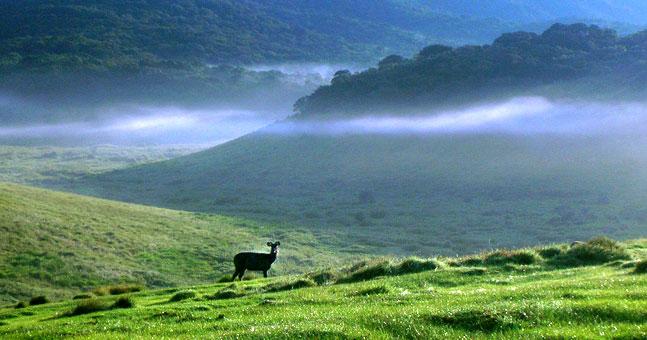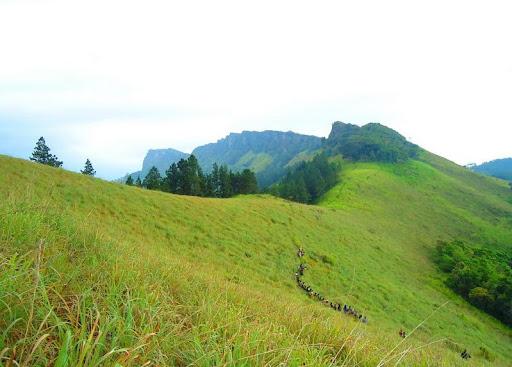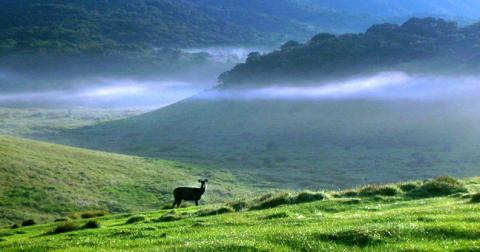Grasslands (wet pathana, dry pathana, savannah, etc)
Very broadly, based on elevation, climate, plant composition and degree of disturbance, six types of grassland ecosystems are recognized in Sri Lanka. They are the following: The wet patana grasslands, found around and above 1800 m altitude, are best seen in Horton Plains and around Nuwara Eliya. They are dominated by the tussock grass species Chrysopogon nodulibarbis and Arundinella villosa on higher ground and Garnotia exaristata and the dwarf bamboo, Sinarundinaria densifolia, close to waterways. A diversity of delicate, small herbaceous species with colourful flowers grow among the grasses. They include Pedicularis zeylanica, Satyrium nepalense, Exacum walkeri, Osbeckia spp., Ranunculus spp. (some very seasonal) and the fern Pteridium revolutum. Rhododendron arboreum ssp. zeylanica about 2 m tall, often displaying spectacular brilliant red flowers, the shorter Gaultheria leschenaultia whose leaves smell of wintergreen and the invasive spiny Ulex europaeus, are the widely scattered woody species in these grasslands.

Hortan Plains
During less wet periods of the year, February to April, these grasslands are subject to accidental fires. These fires, ground frost in January/February, a high water table and herbivory all contribute to the maintenance of these grasslands.
In the early 1960s about 120 ha of wet patina grassland were used for cultivation of seed potato by the Department of Agriculture and later abandoned, following which the area was gradually converted to a carpet-like grassland dominated by the exotic Penesetum sp. This grassland, with its vegetation growing close to the ground, does not provide environmental conditions and microhabitats for the herbaceous flora to thrive, unlike among the tussock grasses of the natural wet patana. Therefore, its floristic richness is much less, and consequently its faunal diversity as well.
Sambhur, wild boar and black-naped hare feed in these grasslands at night but rest in the adjacent forests during the day. The grassland/forest complex provides them an ideal system for survival. Among the other animals recorded are three endemic freshwater crabs (Ceylonthelphusa scansor, Perbrinckia punctata, P. glabra), the endemic shrimp (Lancaris sinhalensis) and among the amphibians Philautus microtympanum, Fejervaryia greenii, Microhyla zeylanica and Polypedates eques inhabit the streams and/or their immediate environs.
Among the wet patana grasslands, the flora and fauna has been best studied in Horton Plains. The dry patana grasslands, located between 500 – 1000 m elevation, are relatively widespread, occurring in the Uva basin, and around Gampola, Nawalapitiya, Hantana and Rakwana. These grasslands have resulted from the removal of tree vegetation for agriculture and subsequent abandonment. The dominant grass species in them are Cymbopogon nardus and Themeda tremula, both forming tussocks. Other species seen among the grasses include a large number of tall composite herbs (Blumea spp., Vernonia spp. etc.) and semi-woody to woody shrubs (Cassia spp., Crotalaria spp., Lantana camara, Osbeckia octandra, Psidium guajava, Wikstroemia indica).
During the dry months these dry patanas are purposely burnt to obtain fresh grass for fodder or to hunt animals. Their very existence is a result of fire. Much of these grasslands are now converted to agricultural land and Pinus and Eucalyptus plantations. They are also being taken over by the aggressively competitive exotic fodder grass Panicum maximum and invasive species like Clusia rosea. Ecology of the vegetation in the dry patana grasslands has been studied at Hantana.

Hantana Mountain Range
The savannas occur in the intermediate and dry zones, between 300–1000 m elevation. Those on the eastern slopes of the central massif and around the Uva basin are called upland savannas while those in Moneragala and Bibile and in the Gal Oya basin are known as lowland savannas. They resemble a parkland, with scattered, fire-tolerant trees dominated by Careya arborea, Phyllanthus emblica, Terminalia chebula, T. bellirica, all with medicinal properties. The ground layer is dominated by the grass species Cymbopogon polyneuros in association with Themeda triandra at higher elevations and Aristida setacea and Panicum sp. at the lower elevations. Savannas are maintained by anthropogenic fires, mostly to facilitate the collection of fallen fruits of the medicinal species. These savannas are used as foraging habitats by elephants and other herbivores, especially when there is new growth of the grass species after they have been set on fire.
Damanas, also known as dry low country parklands or grasslands, occur in the Ampara and Batticoloa districts of the eastern dry zone. They are dominated by the tussock grass Cymbopogon nardus. Other less abundant grass species include Aristida setacea, Imperata cylindrica, Themeda spp., Brachiaria spp., Cyanodon dactylon, Echinocloa colona, Eragrostis sp. and Sporobolus diander. Scattered in the grass are herbaceous (Alisicarpus vaginalis, Desmodium heterophyllum, D. triflorum), woody shrubs (Calotropis gigantea, Cassia auriculata, Lantana camara) and trees (Manilkara hexandra, Pterocarpus marsupium, Acacia leucophloea, Butea monosperma). Damanas provide fodder to wild elephants and buffaloes. Indeed, these animals are largely responsible for the maintenance of this vegetation, which except for their impact, is likely to contain a higher density of woody species. Leaves of Diospyros melanoxylon, locally known as Kadumberiya, growing in this ecosystem are widely used as wrappers for local cigarettes (beedi).
Talawa grasslands occur in the Haldumulla area, where the topsoil is eroded and truncated to some degree. While the tall (1.5 m) tussock grass Cymbopogon nardus dominates them, other less abundant grasses seen are Andropogon lividus, Arundinella villosa, Chrysopogon aciculatus and Themeda tremula. The herbs and shrubs scattered among the grass include Desmodium triflorum, Elephantopus scaber, Evolvulus alsinoides, Lantana camara and Psidium guava.

